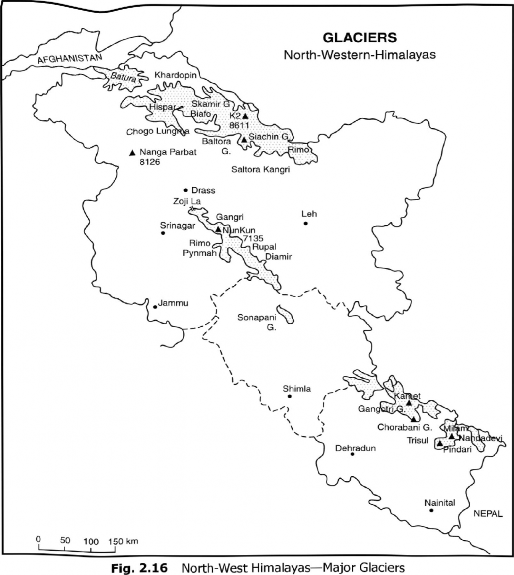Glaciers and Snowline
The lower limit of perpetual snow is known as ‘snowline’. The snowline in the Himalayas has different heights in different parts, depending on latitude, altitude, amount of precipitation, moisture, slope and local topography. In the Himalayas, glaciers (snowfields) cover about 40,000 sq km of area between Karakoram (J & K) and Arunachal Pradesh. There arc about 15,000 glaciers in the Himalayas lying between the two syntaxial bends in the east and the west. In the Assam Himalaya, the snowline is about 4400 m, whereas in the Kashmir Himalayas it varies between 5200 to 5800 m. In the Kumaun Himalaya the snowline is about 5100 m and about 5500 m in the Karakoram. On the Tibetan side, the altitude of the snowline is about 900 m higher owing to great desiccation of the region and scarcity of moisture. Thus, there is a direct relationship between the presence of moisture and the altitude of the snowline. In general, more the moisture in the atmosphere, lower the altitude of the snowline and vice versa.
Table 2.2 Altitude of Snowline in the Himalayas

Himalayan Region | Altitude of Snowline |
1. North Eastern Himalayas (Arunachal Pradesh) | 4400 m |
2. Kashmir Himalayas | 5200 m to 5800 m |
3. Kumaun Himalayas | 5100 m to 5500 m |
4. Karakoram — | 5500 m and above |
The main glaciers in the northern mountains are found in the Greater Himalayas and the Trans-I limalayan mountains (Karakoram, Ladakh and Zaskar). The Lesser Himalayas have small glaciers, though traces of large glaciers are found in the Pir-Panjal and Dhauladhar ranges. Some of the important glaciers of the Karakoram and the Himalayas are given in Fig. 2.16 (Table 2.3).
Table 2.3 Main Glaciers of India
Name of the glacier | Location | Length in km |
1. Siachin | Karakoram | 75 |
2. Sasaini | Karakoram | 68 |
3. Ilispara | Karakoram | 61 |
4. Biafo | Karakoram | 60 |
5. Baltora | Karako ram | 58 |
6. Chogo Lungma | Karakoram | 50 |
7. Khordopin | Karakoram | 47 |
8. Rimo | Kashmir | 40 |
9. Punmah | Kashmir | 27 |
10. Gangotri | Uttarakhand | 26 |
11. Zemu | Sikkim/Nepal | 25 |
12. Rupal | Kashmir | 16 |
13. Diamir | Kashmir | 11 |
Most of the glaciers of the Lesser Himalayas are smaller in size, ranging from 3 to 5 km in length. There are, however, some larger-sized glaciers also in Karakoram and the Greater Himalayas. Some of the important glaciers are Siachen (75 km), Sasaini (68 km), Ilispara (61 km), Biafo (60 km), Baltora (58 km) (Karakoram mountains).The Chogo Lungma Glacier (50 km) terminates at an altitude of 2070 m, the lowest recorded in the Karakoram (Fig. 2.16). In Uttarakhand, Gangotri, Milam and Pindari are the main glaciers. The glaciers of Karakoram are the remnants of the Pleistocene Age. The diurnal rate of movement of these glaciers is between 8 to 15 cm at the side and 20 to 30 cm in the middle. The glaciers of the Pir-Panjal are less numerous and smaller in size as compared to those of the Karakoram and the Greater Himalayan ranges. The longest glacier of the Pir-Panjal is Sonapani glacier in the Chandra Valley of Lahul and Spiti region. Its length is about 15 km at an altitude of about 4000 m near the Rohtang Pass.The largest glacier in the Nun-Kun peak is the Gangri Glacier which is about 13 km in length. The glaciers of the Nanga Parbat Massif are small in size and are moving fast due to a steep slope. The Chungphar, Rakhiot, Buzhi and Tashan are the other important glaciers of the Pir-Panjal Range. The glaciers are not only the source of Himalayan rivers, but also maintain a regular supply of water in these rivers during off-monsoon period. The Himalayan glaciers are, however, receding. According to new Isro satellite

study, 75% of Himalayan glaciers are melting, 8% advancing and 17% showing no change. Commissioned by the environment ministry, the study is different from an IPCC report, claiming, without sufficient evidence, that the glaciers would vanish by 2035 (Times of India 16.5.2011, p l).
